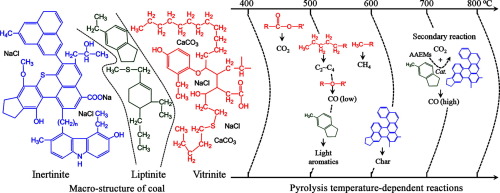当前位置:
X-MOL 学术
›
Appl. Energy
›
论文详情
Our official English website, www.x-mol.net, welcomes your
feedback! (Note: you will need to create a separate account there.)
The evolutionary route of coal matrix during integrated cascade pyrolysis of a typical low-rank coal
Applied Energy ( IF 10.1 ) Pub Date : 2017-05-16 04:14:43 Xiongchao Lin, Meng Luo, Shouyi Li, Yuanping Yang, Xujun Chen, Bin Tian, Yonggang Wang
Applied Energy ( IF 10.1 ) Pub Date : 2017-05-16 04:14:43 Xiongchao Lin, Meng Luo, Shouyi Li, Yuanping Yang, Xujun Chen, Bin Tian, Yonggang Wang

|
In this study, a typical inertinite- and AAEMs (alkali and alkaline earth metal species)-rich Chinese sub-bituminous coal was systematically investigated in terms of maceral component, mineral occurrence and molecular structure. Based on the experimental data, macromolecular-dependent evolutionary behavior during integrated cascade coal pyrolysis was unraveled, and further a mechanism on staged-pyrolysis was proposed. Compelling evidence shows that after heavy medium separation, the features of coal fractions with different densities were significantly varied in maceral compositions, AAEMs distributions and more importantly, in macromolecular structure. The various functional groups abundant in respective maceral-enriched (vitrinite, liptinite, and inertinite) coal fractions behaved distinctively during pyrolysis due to the different activation energies for the scission of these functional groups, thus resulting in temperature-dependent reactions. Specifically, at lower temperature (400–500°C), carboxylic groups mainly inherent in vitrinite could be substantially decomposed into CO2. Subsequently, at ca. 500°C, aliphatic chains in vitrinite were cracked to C2-C4; while ether structures were broken and contributed to the generation of a small amount of CO. Meanwhile, the small aromatic molecules freely existed in liptinite could also be released in form of light aromatics. At higher temperature (ca. 700°C), the volatiles including CO2 would react with char and generate a larger proportion of CO; and particularly, this secondary reaction could be catalytically accelerated by AAEMs at higher temperature. Consequently, the pyrolysis route and gaseous products in different stages were varying in specific manner according to the reaction mechanism; and it was available to direct the production of methane-rich syngas, and provide a useful basis for optimization of cascade coal pyrolysis processes.
更新日期:2017-05-16


















































 京公网安备 11010802027423号
京公网安备 11010802027423号